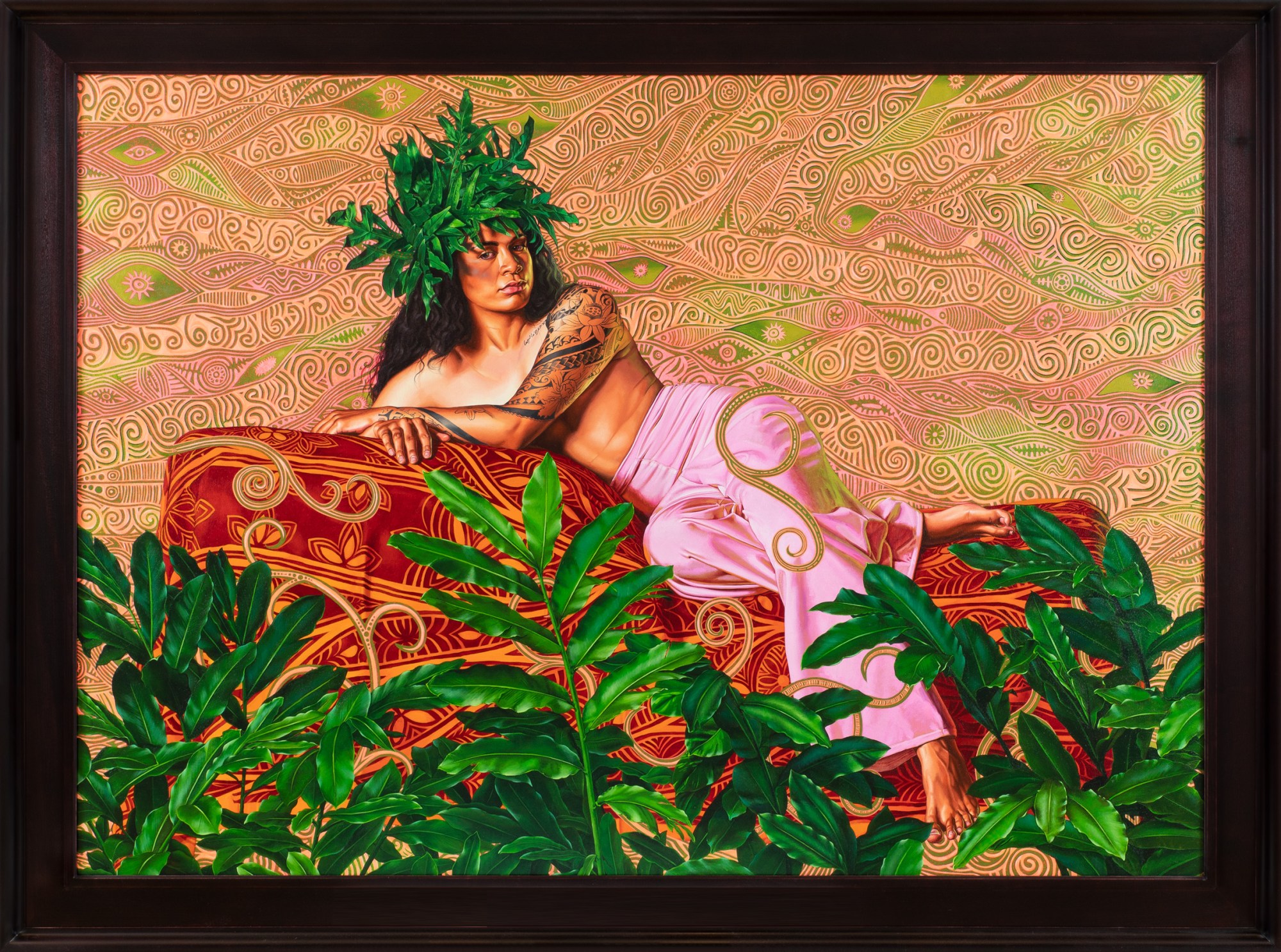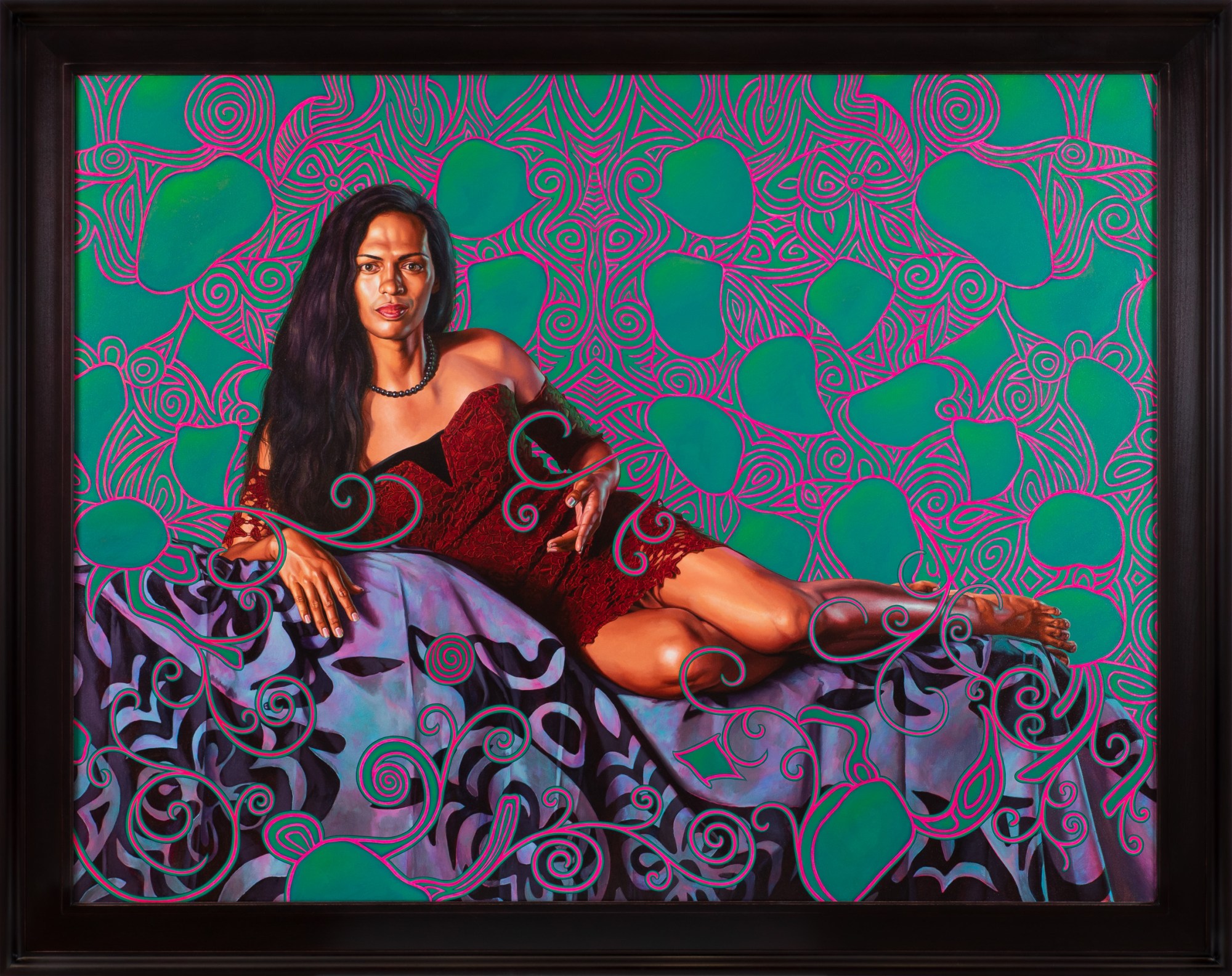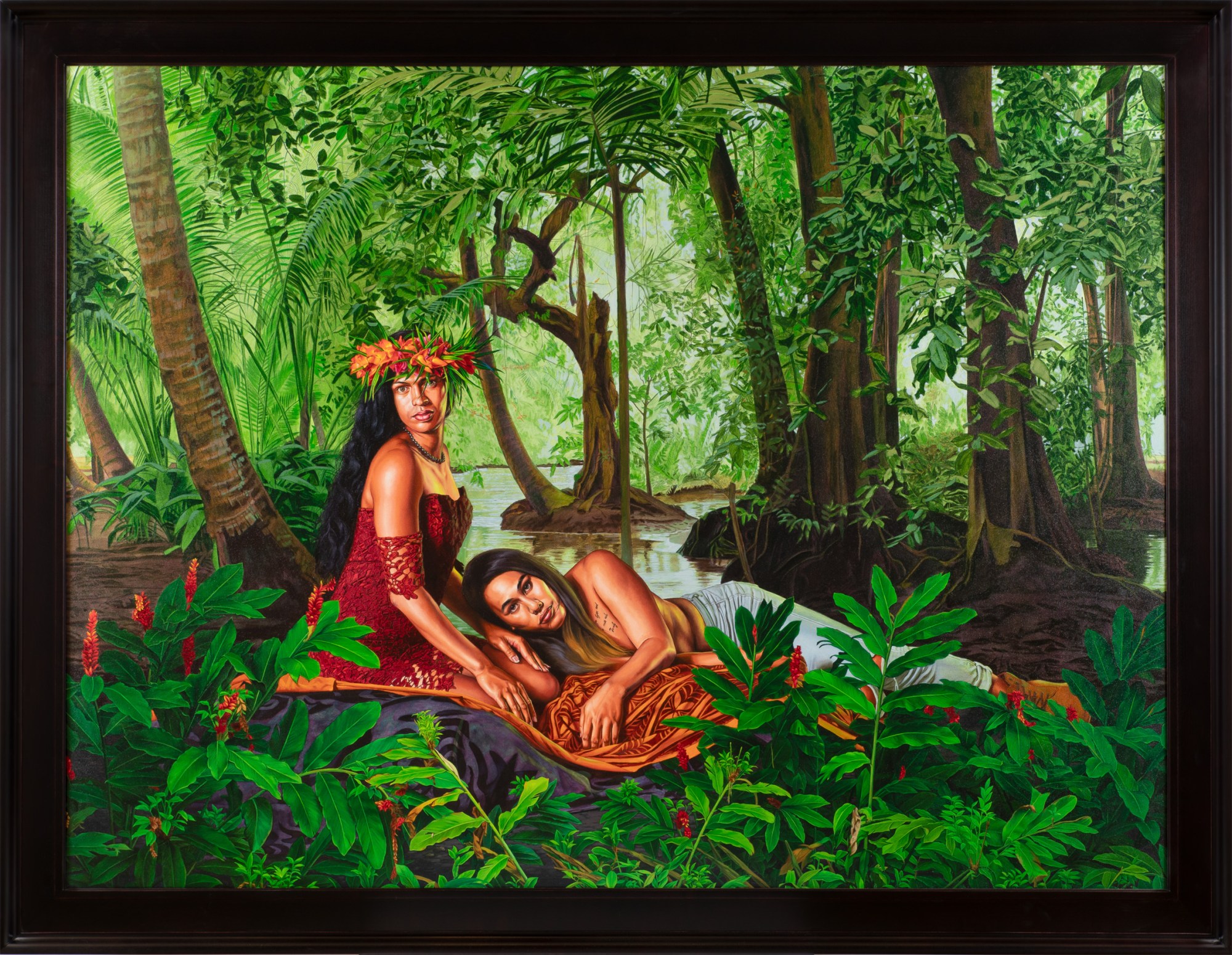Painter Kehinde Wiley at once questions and remixes the art historical canon, giving pride of place to figures who have been omitted from Western cultural discourse and depiction. By its nature, his work prompts a conversation around representation and what troubling absences must be reclaimed. Using the grand styles and techniques of referential Old Masters, à la Titian or Ingres, he impels a more expansive view on inclusion, exalting street-scouted figures of all provenances, be it African-American, South Asian or West African heritage. Wiley’s work reached a new zenith in 2018 when he was commissioned for the official U.S. Presidential portrait of Barack Obama (following the ritual that began in 1994 with George H.W. Bush).
This past weekend, Wiley unveiled a new series of paintings and a video-installation, “Tahiti,” (on view through July 20) at Galerie Templon in Paris. Set against his signature brightly decorative backgrounds—here drawn from linocuts used to produce patterned textiles—his aesthetically impactful series focuses on the Māhū, a community of Tahitian transgender women, whose once-respected legacy was quashed by 19th-century Christian missionaries. The sitters, restored to glory, are magnificent: robust and commanding, direct and unflinching. Wiley’s portraits of these trans women serve as a retort to the work Paul Gauguin made in the region over a century ago, his charged with colonialism and sexual objectification (The Kingdom of Tahiti was officially annexed by France in 1880, and French is still the official language).
While there’s no absolving the past, Wiley is hoping to shape a new future: In June, he will inaugurate Black Rock Senegal, a new artist-in-residency program in Dakar. It provides a sacrosanct hub for creativity outside a Western context while also galvanizing the increasingly structured and fervent local artistic scene. We spoke with Wiley about agency in painting, attempting to dismantle Gaugin’s gaze, and his impatience for inclusion to seem commonplace.
How did this “Tahiti” series start?
France is the seat of power when it comes to grand painting. I wanted to look at Gaugin and his strange, perverse, magical presence in art history. Am I saying ‘yes’ to Gaugin? Yes. Am I saying ‘no’ to Gaugin? Yes. It’s like a dysfunctional family—there are things that you love about those paintings, there are things that you resist. Many people from France went to Tahiti to “find themselves.” I don’t even know what the fuck that means—to go to black and brown nations and “find yourself.” The women I “found”… were firmly rooted in a tradition that is their own.

How did you go about selecting your muses?
The models were scouted in nightclubs, walking through the streets… There’s a sensibility—there’s a grace. I told everyone in this show: wear what you think is appropriate. Many brought several different outfits and looks. We have to get away from notions of ‘those people out there’—those trans people, those brown people, those colonial subjects. Often we look at the people in paintings as being passive. There’s a lot of agency here, and it’s beautiful! And tacky, and flawed, and strange. All of those things come together. The model owns that power; she owns that space. They’re telling their own stories. I know that portraiture is impossible… the philosophical notion that portraiture is able to tell a certain truth is bankrupt. But I’m trying my best to be loyal to the subject. When I talked to the models about Gaugin’s paintings… they feel oversimplified. I said: ‘It’s your time. You do whatever the fuck you wanna do.’
In revisiting history, does it feel possible to dismantle some of its burdens?
There are so many ways in which you can honor and participate in something, but also embrace another set of ideals. It’s code-switching. With regards to art history, some of that stuff is really fucked up. It is honoring it technically: the proficiency, the color use. But there are moments when you say: ‘we can do better, and we can make other decisions.’ I’m at once critical and embracing of the history. I’m sure as hell critical, though I’m not a take-down artist. I’m enamored with the [original Gaugin] paintings and—it’s not a ‘but,’ it’s additive— and we can do better. We can create broader histories and stories that allow those women to speak for themselves. This is their time. It’s a look at Gaugin, but it’s not a ‘fuck you.’ We’re using him as an occasion to create a new conversation. I didn’t recreate his backgrounds or his poses. Those women are much more important than that.

It definitely feels like a new conversation. Today there’s a reframing of narrative, even though we’re also living in a really regressive time, in a lot of scary ways. But Paris’s Musée d’Orsay currently has an unprecedented show on “ Le Modèle Noir: de Géricault à Matisse ,” featuring the role of black subjects in the history of painting, for example.
It’s a very popular show. Finally! And we’re starting to see that we can get people to show up if we simply become inclusive of a population… in modern France, these people exist too. It’s a simple ‘yes.’ That’s all it is. ‘Yes, you too!’ And the numbers go up. People vote with their feet [to create traffic]. It’s not some magic revolution; it’s just common sense. Hi! I feel welcome.
Isn’t it kind of a revolution, though? Because there has been such an astounding lack of visibility and access up until this point.
I know—but aren’t we better than that? I know the answer, sadly. But we’d like to be elsewhere. I’m speaking of what it feels like to be a black man in America who often feels invisible. As a young teenager, seeing Kerry James Marshall’s work at LACMA—that beautiful barbershop piece—out of all these images of whiteness… There was this one possibility of seeing black skin. It was earth-shattering. If I can effect any kind of change or conversation… I want non-traditional artists to have a seat at the table.
This is your first overt focus on trans identity. Is this something you will do again?
There are paintings of trans identity that I’ve created heretofore, but the decision to create a show around the trans community was about France, it was about Gaugin, it was about colonialism and empire. I had all of these big conceptual ideas in my head. And then I met people and had human experiences, it became more personal. I hope that the show can travel to Tahiti, so the subjects can see themselves, and the broader community can celebrate them.

You’ll have a show in October featuring your equestrian painting “ Napoleon Leading the Army Over the Alps ” alongside the Jacques-Louis David one it was inspired by . It will be exhibited at Château de Malmaison—the retreat Napoleon and his wife shared outside of Paris. Does this context feel momentous?
Power is tricky and vulgar and obvious—look at the American president. But art has been the recorder or witness to power, be it the church or state, for centuries… it’s really propaganda. It’s about convincing the world of your potency and power. Do we really ever get rid of the past, or can we somehow find a graceful way to deal with what has happened? The Napoleon painting is about celebrating people who look like me, who have been ignored.
Are there other painters whose work you would like to revisit?
History has been a great model for me. I’ve looked at the great masters, all of the Old Dead White Men who’ve come before me as a means by which to analyze contemporary society. But honestly, I shouldn’t fall into a pattern where simply ‘then plus now equals something else.’ The last couple of years, it’s less about history-with-a-capital-H or the anxiety of influence, but rather: how do you create a type of poetry of painting? That’s where the work is right now. If I’m honest to that little black boy who just really loves painting, no matter how famous or rich or known he is, just addressing that itch that I had before Yale, before New York… If I stay honest to that thing that’s inside me? Nobody can fuck with that.

